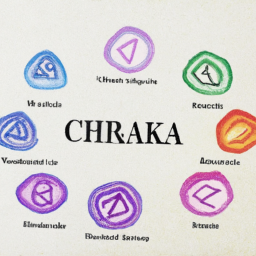Chakras are an integral part of the ancient Indian system of medicine and healing known as Ayurveda. These energy centers are believed to play a key role in maintaining physical, emotional, and spiritual well-being. However, despite their popularity and significance in Eastern practices, many people are left wondering – where are chakras located?
To answer this question, we must first understand what chakras are and how they function. According to Ayurveda, chakras are circular centers of energy located along the spinal column. There are seven main chakras, each corresponding to a different aspect of our being – physical, emotional, mental, and spiritual. These energy centers are said to be connected by a network of channels that run through our bodies, known as nadis.
Drawing from the ancient Vedic texts, the seven chakras are described as follows:
1. Root Chakra (Muladhara): Located at the base of the spine, this chakra is associated with the physical body, survival instincts, and the sense of grounding.
2. Sacral Chakra (Svadhisthana): This energy center is located just below the navel and is linked to emotions, creativity, sexuality, and pleasure.
3. Solar Plexus Chakra (Manipura): Situated above the navel, this chakra governs personal power, confidence, and self-esteem.
4. Heart Chakra (Anahata): Located in the center of the chest, this chakra is associated with love, compassion, and relationships.
5. Throat Chakra (Vishuddha): Found in the throat, this chakra is linked to communication, self-expression, and the ability to speak our truth.
6. Third Eye Chakra (Ajna): This chakra is located between the eyebrows and is associated with intuition, insight, and imagination.
7. Crown Chakra (Sahasrara): Situated at the top of the head, this chakra is considered the highest energy center and represents our connection to the divine or universal consciousness.
Now that we know where the chakras are located, it’s important to understand how they function. The chakras are constantly in a state of flux, absorbing and emitting energy. When all chakras are balanced and functioning properly, a person experiences physical, emotional, and spiritual harmony. However, when a chakra becomes blocked or imbalanced, it can manifest in various physical or psychological ailments.
So, how can we keep our chakras in balance and ensure their proper functioning? Ayurveda offers several methods such as yoga, meditation, pranayama (breathwork), and chakra balancing techniques. These practices help to unblock and balance the flow of energy in the chakras and promote overall well-being.
In addition to these practices, Ayurveda also emphasizes the importance of maintaining a healthy lifestyle. Proper nutrition, regular exercise, and a peaceful mind are essential for maintaining balanced chakras. Ayurvedic herbs and oils are also believed to help harmonize the chakras and promote overall health.
In conclusion, chakras are powerful energy centers that play a crucial role in our physical, emotional, and spiritual well-being. They are located along the spinal column and are connected by a network of nadis. By understanding their location and how they function, we can take steps towards maintaining a healthy and balanced chakra system. Incorporating Ayurvedic practices into our daily routines can help to unblock and balance our chakras, leading to a more vibrant and fulfilling life.





That’s a great question!
Petra_Kulsoom: I’m so curious to hear the answers!
It’s an interesting topic – chakras are believed to be energy points in our bodies associated with various physical, psychological and spiritual dimensions. They are thought to be connected to our overall health and wellbeing, and aligning them can lead to a more balanced life.